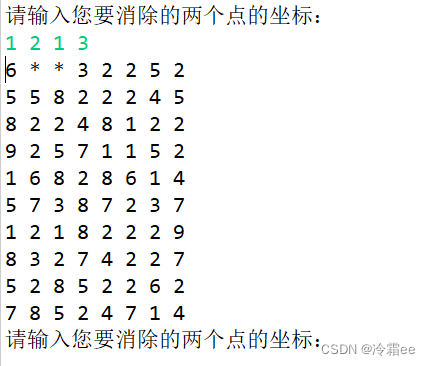Java连连看
开发环境:win10、jdk8、eclipse
程序截图:

输入消除的坐标进行游戏

程序代码:
package com.it.yzw.Link;
import java.util.Random;
import java.util.Scanner;
/**
* Java版连连看
* @author Yang
*
*/
public class Link{
// 全局变量
public static int row = 10; // 定义了一个全局的静态变量
public static int col = 8;
// 定义游戏的二维数组
// 1、首先,第一步,二维数组是行和列的排列的最有体现,因此,我们这个游戏区域,就可以用二维数组
// 注意:10行,8列
public static int[][] map = new int[row][col];
public static Random r = new Random();
public static Scanner sc = new Scanner(System.in);
// 游戏结束的变量
public static boolean isGameOver = false;
// 消除的次数
public static int count = 0;
// 开始时间
public static long startTime = System.currentTimeMillis();
// 游戏时间为60s
public static int time = 60;
public static void main(String[] args){
// int a = 10; // 局部变量,只能在main方法里面访问
// 2、二维数组出来之后,要随机赋值 1~9的数字
// 注意:为了保证游戏能过顺利结束,我们的随机的数字,必须保证偶数个
for(int i =0; i < map.length; i++){
for(int j = 0; j < map[i].length; j += 2){
int temp = r.nextInt(9) + 1;
map[i][j] = temp;
map[i][j+1] = temp;
}
}
// 3、数字随机出来之后,打乱顺序
for(int i = 0; i < row * col; i++){
// 随机交换两个值的位置
// 在数组里面随机取值,应该随机的是索引
int x1 = r.nextInt(row);
int y1 = r.nextInt(col);
int x2 = r.nextInt(row);
int y2 = r.nextInt(col);
// 开始交换
int temp = map[x1][y1];
map[x1][y1] = map[x2][y2];
map[x2][y2] = temp;
}
// 定义一个方法,用来显示游戏
show();
System.out.println("游戏开始");
// 用户一直来输入
while( !isGameOver){
System.out.println("请输入您要消除的两个点的坐标:");
int x1 = sc.nextInt() - 1; // 索引从0开始,所以要减1
int y1 = sc.nextInt() - 1;
int x2 = sc.nextInt() - 1;
int y2 = sc.nextInt() - 1;
// 接着,判断能不能消除
if ( x1 == x2 && y1 == y2){
System.out.println("同一个点,不能消除");
}else if( map[x1][y1] != map[x2][y2] ){
System.out.println("两个点的值不一致,不能消除");
// 开始判断游戏的消除逻辑了
}else if( oneLine(x1,y1,x2,y2) || twoLine(x1,y1,x2,y2) || threeLine(x1,y1,x2,y2)){
// System.out.println("可以消除");
// 还没有学线程,因此,做不了实时判断,只能消除的时候判断
long endTime = System.currentTimeMillis();
// 判断有没有超时
if( endTime - startTime >= time * 1000){
System.out.println("游戏超时");
isGameOver = true;
break;
}
// 消失掉
map[x1][y1] = 0;
map[x2][y2] = 0;
// 消除奖励时间
time++;
// 消除一次加一次
count++;
if( count == row * col / 2){
System.out.println("恭喜过关");
isGameOver = true;
}
}else{
System.out.println("规则不符,不能消除");
}
// 重新展示游戏区域
show();
}
}
// 单线消除
public static boolean oneLine(int x1, int y1, int x2, int y2){
int min = 0;
int max = 0;
if(x1 == x2){
min = y1 > y2 ? y2 : y1;
max = y1 > y2 ? y1 : y2;
// 同行 不能直接从y1循环到y2,应该是从小的循环到大的
for(int i = min + 1; i < max; i++){
// 判断,里面的值,有没有不等于0的
if( map[x1][i] != 0){
// 意味着不能通过,单线消除这边不行
return false; // return的特点:这个方法,会直接结束,不会再继续往下运行了
}
}
return true;
}else if(y1 == y2){
min = x1 > x2 ? x2 : x1;
max = x1 > x2 ? x1 : x2;
// 同列
for(int i = min + 1; i < max; i++){
if( map[i][y1] != 0){
return false;
}
}
return true;
}
return true;
}
// 双线消除
public static boolean twoLine(int x1, int y1, int x2, int y2){
// 先定义两个转折点
int zx1 = x1;
int zy1 = y2;
int zx2 = x2;
int zy2 = y1;
// 双线消除,转换为a-z的单线,z-b的单线
if( map[zx1][zy1] == 0 && oneLine(x1,y1,zx1,zy1) && oneLine(zx1,zy1,x2,y2)){
return true;
}
if( map[zx2][zy2] == 0 && oneLine(x1,y1,zx2,zy2) && oneLine(zx2,zy2,x2,y2)){
return true;
}
return false;
}
// 三线消除
public static boolean threeLine(int x1, int y1, int x2, int y2){
// 三线消除,与点A的同行/同列,都有可能是我们的转折点
int zx1 = x1;
int zy1 = 0;
for(int i =0; i < col; i++){
zy1 = i;
// a-z的单线,z-b的双线
if(map[zx1][zy1] == 0 && oneLine(x1,y1,zx1,zy1) && twoLine(zx1,zy1,x2,y2)){
return true;
}
}
// 同列循环行
int zx2 = 0;
int zy2 = y1;
for(int i =0; i < row; i++){
zx2 = i;
if(map[zx2][zy2] == 0 && oneLine(x1,y1,zx2,zy2) && twoLine(zx2,zy2,x2,y2)){
return true;
}
}
return false;
}
// 定义方法
public static void show(){
for(int[] arr : map){
for(int num : arr){
if( num == 0){
System.out.print("*" + " ");
}else{
System.out.print(num + " ");
}
}
System.out.println();
}
}
}